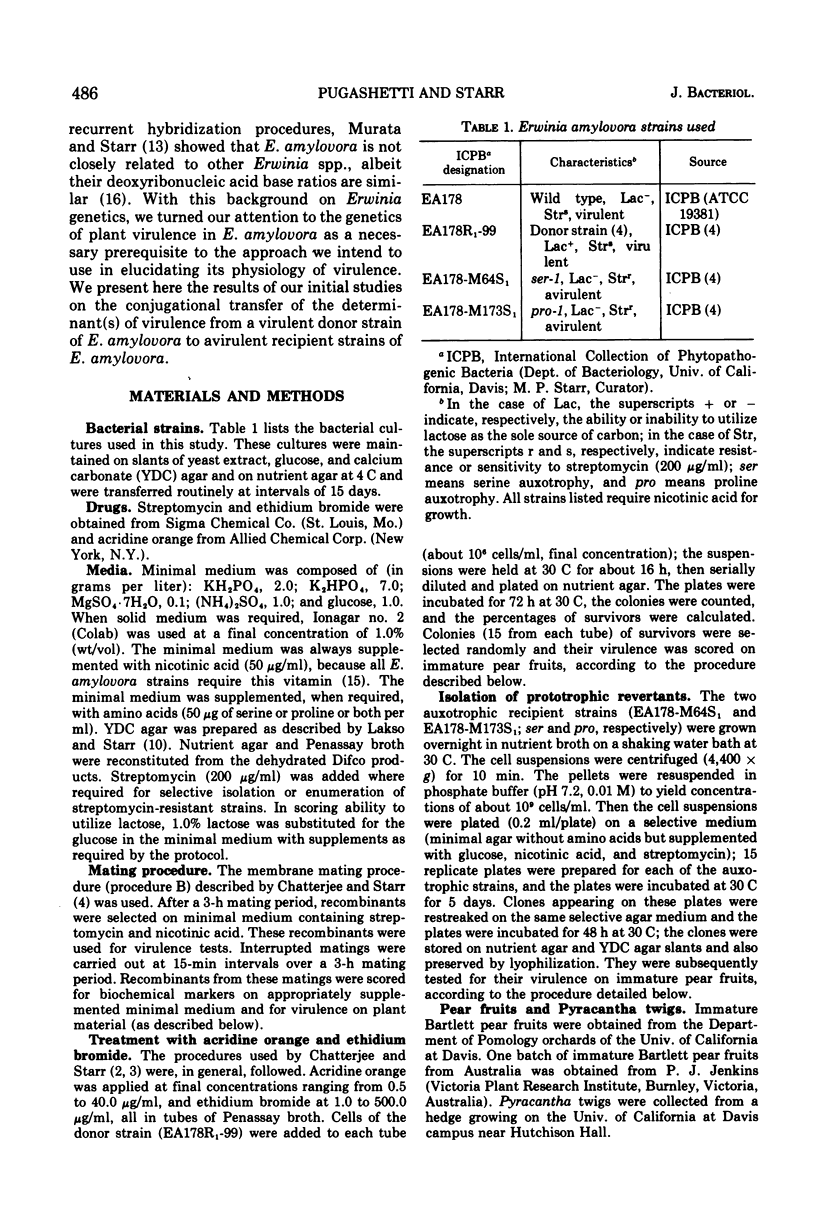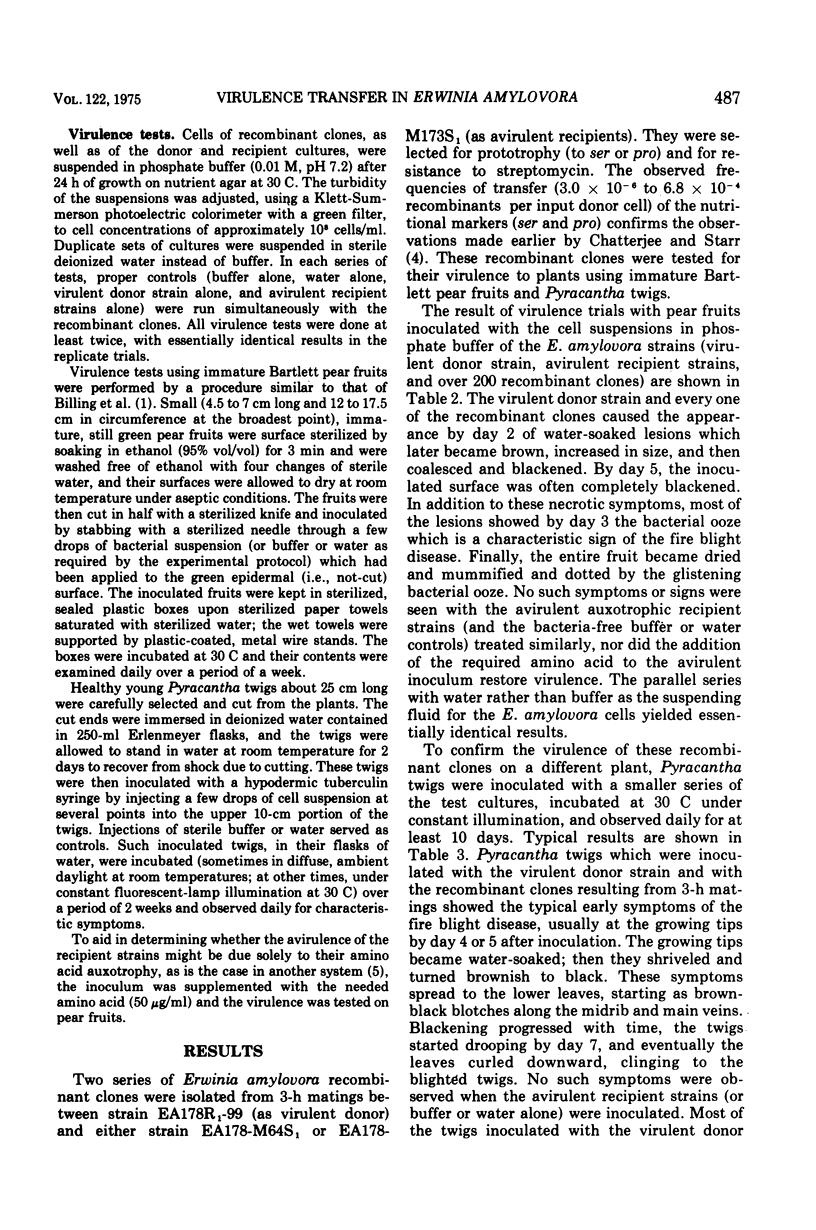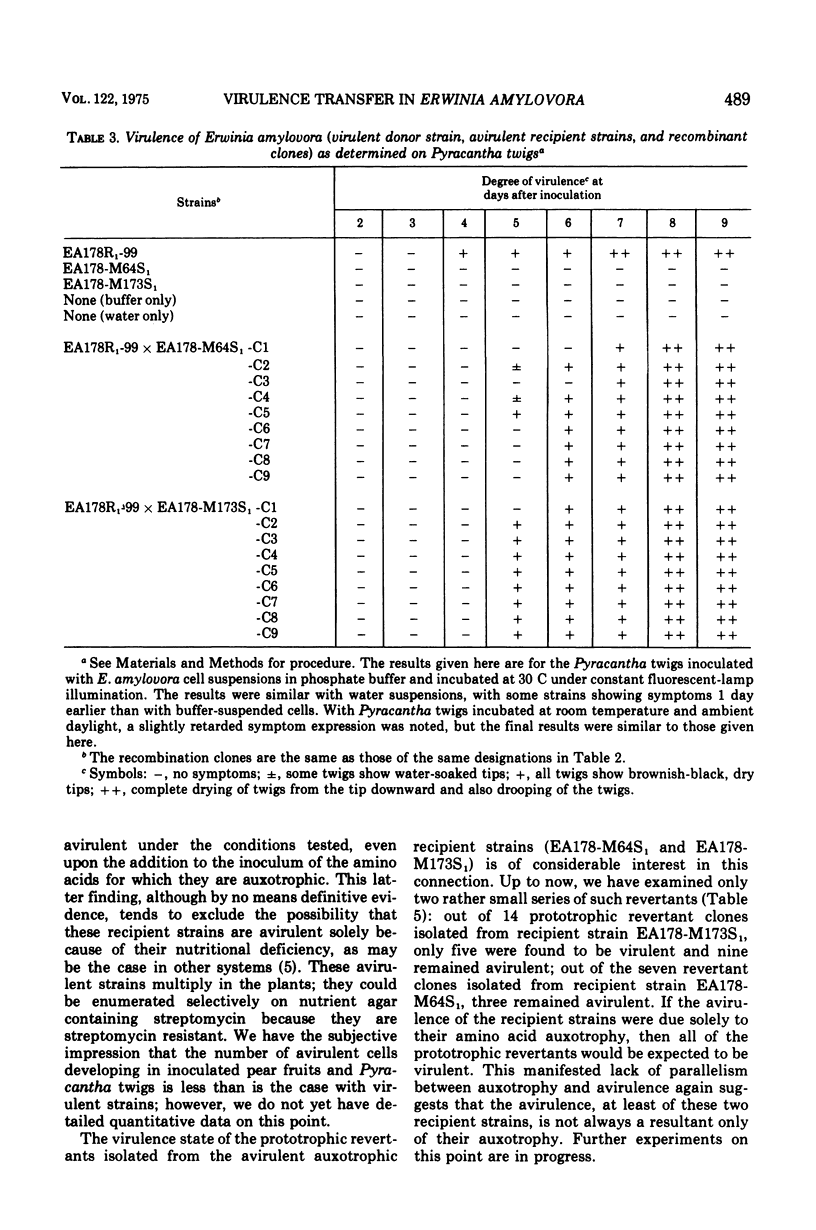Abstract
A stable virulent donor strain (EA 178R1-99) of Erwinia amylovora can transfer, by conjugation during a 3-h mating period, the gene or genes which determine(s) plant virulence to avirulent recipient strains (EA178-M64S1 and EA178-M173S1) of Escherichia amylovora. The virulence of over 200 recombinant clones was tested; they all were as virulent on immature Bartlett pear fruits (and, in the smaller series of strains tested, also, on Pyracantha twigs) as was the parent donor strain. Although the avirulent recipeint strains are amino acid auxotrophs, addition of the required amino acids to the inocula in plant virulence trials does not of itself restore virulence. Two small series of prototrophic revertant clones were selected from the auxotrophic avirulent recipient strains; only nine of the 21 prototrophic revertant clones regained virulence, whereas the other 12 prototrophic revertant clones remained avirulent, again suggesting a lack of parallelism between nutritional status and virulence in this system. Preliminary interrupted mating trials, carried out at 15-min intervals over 3 h, show that ser is transferred during the first 15 min, that pro starts entering at about 75 min (and with a higher frequency later), and that lac (originating from an integrated Escherichia coli F'lac) enters toward the end of the 3-h mating period and at a reduced frequency compared to the other markers. The gene or genes which determine(s) plant virulence in this Escherichia amylovora donor strain appear(s) to be transferred readily and seemingly completely to recipient strains during the first 15 min of a 3-h mating period. Exposure of the virulent donor strain to acridine orange or ethidium bromide does not result in loss of virulence, suggesting (but, of course, not proving conclusively) that the determinant(s) of virulence in Escherichia amylovora might be chromosomal rather than extrachromosomal.
Full text
PDF






Selected References
These references are in PubMed. This may not be the complete list of references from this article.
- Chatterjee A. K., Starr M. P. Gene transmission among strains of Erwinia amylovora. J Bacteriol. 1973 Dec;116(3):1100–1106. doi: 10.1128/jb.116.3.1100-1106.1973. [DOI] [PMC free article] [PubMed] [Google Scholar]
- Chatterjee A. K., Starr M. P. Genetic transfer of episomic elements among Erwinia species and other enterobacteria: F'Lac+. J Bacteriol. 1972 Jul;111(1):169–176. doi: 10.1128/jb.111.1.169-176.1972. [DOI] [PMC free article] [PubMed] [Google Scholar]
- Chatterjee A. K., Starr M. P. Transfer among Erwinia spp. and other enterobacteria of antibiotic resistance carried on R factors. J Bacteriol. 1972 Oct;112(1):576–584. doi: 10.1128/jb.112.1.576-584.1972. [DOI] [PMC free article] [PubMed] [Google Scholar]
- Coplin D. L., Sequeira L., Hanson R. S. Pseudomonas solanacearum: virulence of biochemical mutants. Can J Microbiol. 1974 Apr;20(4):519–529. doi: 10.1139/m74-080. [DOI] [PubMed] [Google Scholar]
- Erskine J. M. Association of virulence characteristics of Erwinia amylovora with toxigenicity of its phage lysates to rabbit. Can J Microbiol. 1973 Jul;19(7):875–877. doi: 10.1139/m73-139. [DOI] [PubMed] [Google Scholar]
- Goodman R. N., Huang J. S., Huang P. Y. Host-Specific Phytotoxic Polysaccharide from Apple Tissue Infected by Erwinia amylovora. Science. 1974 Mar 15;183(4129):1081–1082. doi: 10.1126/science.183.4129.1081. [DOI] [PubMed] [Google Scholar]
- Lakso J. U., Starr M. P. Comparative injuriousness to plants of Erwinia spp. and other enterobacteria from plants and animals. J Appl Bacteriol. 1970 Dec;33(4):692–707. doi: 10.1111/j.1365-2672.1970.tb02252.x. [DOI] [PubMed] [Google Scholar]
- Murata N., Starr M. P. Intrageneric clustering and divergence of Erwinia strains from plants and man in the light of deoxyribonucleic acid segmental homology. Can J Microbiol. 1974 Nov;20(11):1545–1565. doi: 10.1139/m74-242. [DOI] [PubMed] [Google Scholar]
- STARR M. P., MANDEL M. The nutrition of phytopathogenic bacteria. IV. Minimal nutritive requirements of the genus Erwinia. J Bacteriol. 1950 Nov;60(5):669–672. doi: 10.1128/jb.60.5.669-672.1950. [DOI] [PMC free article] [PubMed] [Google Scholar]
- Starr M. P., Chatterjee A. K. The genus Erwinia: enterobacteria pathogenic to plants and animals. Annu Rev Microbiol. 1972;26:389–426. doi: 10.1146/annurev.mi.26.100172.002133. [DOI] [PubMed] [Google Scholar]
- Starr M. P., Mandel M. DNA base composition and taxonomy of phyopathogenic and other enterobacteria. J Gen Microbiol. 1969 Apr;56(1):113–123. doi: 10.1099/00221287-56-1-113. [DOI] [PubMed] [Google Scholar]


